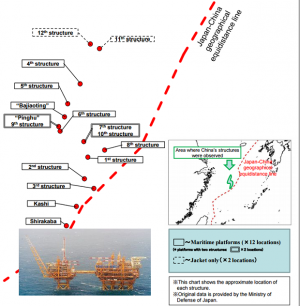Japan reveals evidence of Chinese activities in East China Sea
The Japanese government released a map on Wednesday showing the locations of offshore structures constructed by China in the East China Sea as well as 14 aerial photos.
“In recent years, China has actively been developing resources in the East China Sea,” Chief Cabinet Secretary Yoshihide Suga said at a press conference on Wednesday afternoon.
“We decided to post a map on the Foreign Ministry’s website showing the locations of the structures as well as their photos.”
The structures appear to be offshore platforms related to gas fields.
Article continues after this advertisementSuga said the government has confirmed 16 structures so far, including the 12 structures that were discovered since June 2013.
Article continues after this advertisementSuga expressed strong regret over Beijing’s unilateral move to develop the structures.
He said Japan and China have yet to demarcate boundaries between the two countries in the East China Sea, and that Japan maintains its position of demarcating the boundaries based on the Japan-China median line.
“Even though the development is on China’s side of the median line, it is extremely regrettable that China is proceeding with unilateral development, given the situation in which the boundaries have not yet been demarcated,” Suga said.
The government called on Beijing to halt such unilateral development and will continue to urge it to accept resuming talks at an early date on the implementation of an agreement reached in June 2008 on Japan-China cooperation in resource development in the East China Sea, according to Suga.
Suga said the government decided to release the map with the photos because China has been continuing unilateral development while being reluctant to resume negotiations over the implementation of the June 2008 accord.
He also noted that interest has been growing at home and abroad over China’s unilateral attempts to change the status quo.
Suga said, however, that bilateral relations would not be affected.
Japan’s security could be significantly affected if the offshore facilities are converted to also serve military purposes.
The government is therefore aiming to deter China by demonstrating to the international community the fact that China has been unilaterally developing gas fields.
The offshore facilities are primarily intended for drilling, processing and storing natural gases found under the seabeds and other marine natural resources.
Some experts have raised concerns however that China could utilize the facilities as military bases by installing air defense radar systems and heliports for reconnaissance helicopters.
The government has been demanding that China stop construction of the facilities since June 2013, but has been reluctant to publicize data about the conditions of the developments.
However, according to a government source, the stance was changed because they felt “it was better to publicize the data to the international community as evidence that shows China’s high-handed maritime advances following land reclamation in the South China Sea.”
Originally posted: 11:36 AM July 23rd, 2015
